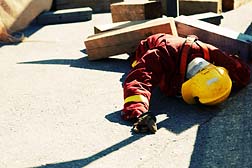 General contractors usually maintain a set of safety rules for all subcontractors and suppliers to follow while on site. As a contractor, establish basic safety standards you require on site. Don’t accept less for your employees than a safe workplace including other trades.
General contractors usually maintain a set of safety rules for all subcontractors and suppliers to follow while on site. As a contractor, establish basic safety standards you require on site. Don’t accept less for your employees than a safe workplace including other trades.- Sound. Construction sites are noisy workplaces under the best of conditions. Hearing protection is often required. So why do some sites allow radios and music boxes? The added decibels hurt, the distraction unwise, inability to hear back up warnings dangerous, and competing music choices raise the sound level and create animosity on site.
o Ban all radios and music boxes, or any other extraneous noise producer.o Ban cell phone use, including texting, except for supervisors.o Turn off unused generators.
- Sight. Safety eye wear, everyone. Anyone not wearing safety eye wear grants permission for others to follow. Don’t allow this slippage to begin. Workers wear reflective vests or bright colors for easy identification. Make them be seen.
o Everyone wears safety eye wear.o Reflective vests or bright colored uniforms for easy location.
- Smell. Smoking on a job site covers important warning odors like gas leaks or electrical fire. Careless disposal of cigarettes is the second leading cause of construction fires.
o Ban all smoking from the site.
- Proper Attire. Loose clothing catches on edges and rotating shafts. Work pants, no shorts, and steel-toed shoes prevent injuries to the legs and feet. Easy to spot colors. Require hard hats.
Safe work is productive work.
Other issues which should be discussed prior to mobilizing on site include work space access and shared use on site. Address adequate storage, security, and any issues with two crews occupying the same space at the same time. Safety issues should not be compromised or run by committee. Insist on protecting your employees with site-wide minimum expectations of safe practices. Most general contractors will welcome the support.





